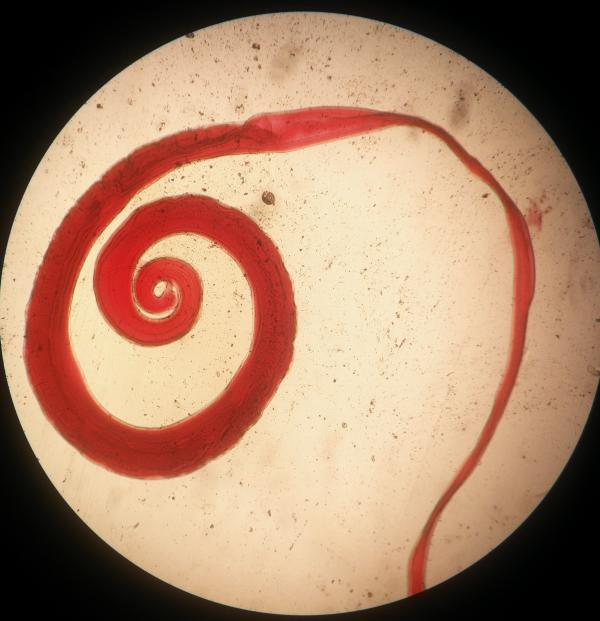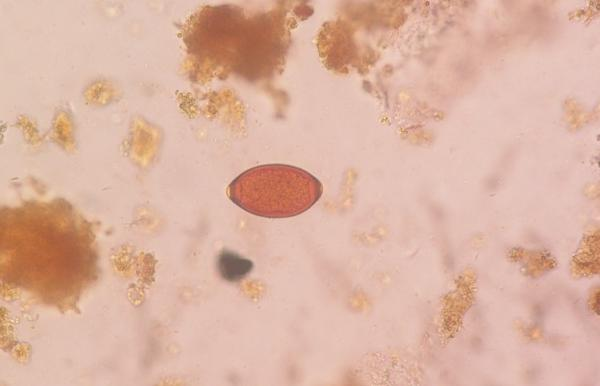Recent studies determine an approximate 800 million cases in the world of parasitosis by the helminth (worm) Trichuris trichura, also known as Trichocephalus for its anatomical characteristics:
Tricho: Hair, in Greek.
Cephalus: Head, in Greek.
Although these registered cases are mostly represented by asymptomatic infections, there are two realities that awaken the clinical interest regarding the treatment and prevention of this pathology: the highest prevalence of this disease is registered in pediatric patients at school age (from 5 to 10 years), and in massive infections it presents chronic diarrhea and dysenteric (with mucus and characteristic blood), which in turn generates anemia, severe abdominal pain, rectal prolapse and tenesmus.
In consideration of these implications, we induce the relevance of the study of this topic to the field of research, and present its theory together with a curious case of Massive Trichuriasis in an adult patient.
Trichuriasis

Male of Trichuris trichura.
Microscopic image obtained from "Parasitologíaenmicro" for academic purposes.
The helminths are characterized by their elongated shape, like a worm. This nematode is cosmopolitan; however, its higher prevalence in tropical, humid and rainy regions. Like any parasite, its incidence increases as the levels of poverty, malnutrition increase, and decrease with the healthiness and good management of food.
Being a parasite with intestinal clinic, it is easy to determine that there will be your goal to stay when infecting. The female (seen in the illustration below), is located in a portion of the large intestine and deposits up to 20 thousand eggs laden with larvae a day. These eggs are expelled by the feces, and from there they begin to segmentation to carry out an embryogenesis process that can last between 15 to 30 days; being able to survive in that phase for years.
The adult worm, already developed and habituated in the human intestine, is approximately 4 centimeters long, and has two segments: one anterior, thin, and the other thicker posterior (demonstrable in the image). With an anterior third remains attached to the intestinal mucosa, and its caudal portion is free to defecate, copulate and release the eggs in the intestinal lumen.

Female of Trichuris trichiura.
Microscopic image obtained from "ParasitologíaEnMicro" for academic purposes.
Thus, we can make a visual image of the injury caused by the whipworms when penetrating the intestinal mucosa, causing a mechanical traumatism that results in inflammation, edema and petechial hemorrhages. As the number of parasites attached to the intestine increases, the clinical and severity of the infection increases.
The hypochromic anemia is explained, not only by the hemorrhage, but also by the parasitic hematogenous diet (although this is not the only means of feeding). However, one of the clinical signs of greater importance in pediatric cases is the arrest of the child's growth, a clinical event that increases in incidence as the number of nematodes increases and parasitizes the patient. There are many speculations for this sign, but there is still no answer to why this pathophysiological manifestation occurs.
Clinic
Understood the pathogenesis of the disease, we can understand a simple clinical formula:
The symptomatology is directly proportional to the number of parasites in the body.
So if the parasitosis is mild, so will his clinic, presenting almost always asymptomatically. More children who have this parasite without knowing it, than those who show any sign of it; in fact, they are usually found accidentally when they find the eggs in the coproparasitoscopic examination.
On the other hand, and by virtue of the same statement, when we speak of massive parasitosis, the patient will present characteristic diarrhea with repeated dysenteric crises (mucus and blood, mucus and blood...), as well as tenesmus, meteorism and rectal prolapse in where it has even been possible to visualize some parasites attached to the skin of the prolapsed rectum.
All this adds, mainly in pediatric cases, severe hypochromic anemia, dehydration, nausea, weakness, fatigue and vomiting; in addition to stopping the growth and deterioration of school performance.
Diagnosis

Microscopic image obtained from "ParasitologíaEnMicro" for academic purposes.
It is not difficult to imagine at this point that the diagnosis will depend on three factors: clinical, epidemiological and laboratory.
The phrase "the clinic speaks" is a reality in medicine, when mentioning the prominence of signs and symptoms as diagnostic methods above laboratory and epidemiology; However, when we talk about parasitic diseases, this usually becomes a bit subjective. Mainly due to the fact that in mild and moderate cases there is usually no great clinical manifestation and, second, because some of the signs tend to resemble other parasites.
That is why the coproparasitological methods of diagnosis are ideal in these tables, in order to determine the presence of the eggs of the parasite in the feces and, consequently, in the intestine. The other methods will be ignored because they are considered unnecessary to mention in this study.
Treatment
The pharmacological treatment par excellence for this class of parasitosis are Benzimidazoles.
The intake of Mebendazole 100 mg twice a day, for three days, is a treatment applicable for all ages.
*Albendazole is also prescribed at a dose of 400 mg per day, for three days and also Flubendazole 300 mg, per day and for two days, or 500 mg at a single dose.
Even the treatments consist of specific anthelmintics that act slowly, inhibiting the uptake and use of glucose by the worm. They take 4 days to be eliminated by faecal route once dead.
It is not recommended to use them in pregnant women.
In consideration of the epidemiology, the prophylaxis consists of correcting the hygienic negligences in the personal scope, and improving the handling of foods, the sanitation and preparation of the same ones.
CLINICAL CASE OF MASSIVE TRICHURIASIS IN AN ADULT PATIENT.
As the clinic speaks, the detailed review of clinical cases facilitates the mental illustration of all the theory applied before. This I say as a student, I see myself in need of refreshing time after time the knowledge researching about stories of diseases to settle my ideas about the study.
That is why, for the sake of the personal study and the benefit of the scientific communion that this space allows us, I will publish a clinical case obtained from a Costa Rican Medical Journal in which six doctors looked for four clinical cases with characteristic and interesting manifestations for the study.
Clinical case
"Male patient of 16 years of age, single.
He entered the San Juan de Dios Hospital on July 26, 1966.
History of diarrhea almost continuous from the age of one and a half years with abundant, liquid stools, in a number of 10-20 a day, brown, with periods of calm of 2-5 days, about 15 times a year, times in which bowel movements were soft, 3-5 in number per day, and abdominal pain, asthenia and weight loss.
Family background.
His brother: intestinal parasitosis.
Personal history:
Deplorable socio-economic conditions.
The physical examination revealed somatic, intellectual, weight and sexual deficit.
Weight: 54 pounds; size: 133 cm; T.A: 90/60; pulse 100 / minute; Temperature 36.89C.
Normocephalus, tooth decay, thin, normoconfigured neck, symmetrical thorax with normal cardiopulmonary exploration. Abdomen soft, depressible, moderately painful in all its extension, without masses or splanchnomegalies.
Laboratory analyzes revealed:
Total proteins 5.7 g% with albumin 2.8 g% and globulins 2.9 g%, urine, alkaline fasfatase, inorganic phosphorus, SGP-T, SGO-T, V.D.R.L. and normal calcium. 67% Prothrombin. Hemoglobin 9.2 G%; Hto 34%, 6,450 leukocytes with 26% eosinophilia and anisopoikylocytosis.
In a D-xylose test, 22.98% of the given dose was recovered.
The count of whipworm eggs showed 133,800 per gram of feces.
Gastroduodenal series and intestinal transit with barium were normal.
A normal chest radiograph.
Three rectosigmoidoscopies were revealing the improvement; in the first there were areas of about 10 mm. of diameter in the mucosa ulcerated, bleeding and abundant whitish parasites that upholstered all the mucosa (15 x 0.3 mm.).
The biopsy taken revealed "rectal mucosa with chronic inflammation, trichocephalosis". The last rectosigmoidoscopy was normal.
The treatment was Furoxone 400 mg. newspapers for 10 days. Enemas of 600 mg of Netocyd in 500 ce. of water, to retain, one daily for 3 days. Enemas of Exilresorcional to retain one every 48 hours number 3. Diet without gluten.
The course was afebrile and as he got better from his diarrhea, he gained weight. In the end he had one or two stools a day, hard, normal looking.
The weight during discharge was 64.5 pounds. "
References
Alvarez CR. Trichuriosis In: Faculty of Medicine: Departmental Manuals, Parasitology, fascicle IV. Department of Microbiology and Parasitology, Faculty of Medicine. Mexico City: Edic
UNAM, 2002: 109-111.Alvarez A, González M, Puga R, Bidot C. Prevalence of intestinal parasitism in supposedly healthy children. Evaluation of your humoral immunity. Rev Cub Med Gen Integr 1993; 9: 220-224.
Vázquez TO. Antiparasitories: trichocephalosis. In: González SN, Saltigeral SP eds. Antimicrobial, antiviral, antiparasitic, antifungal and immunomodulatory. 5th ed. Mexico City: McGrawHill, 2001: 230-253.
Clinical Case Reference
- Miranda, M. et al. Medical Act Cost. 11 (I) 79. 86; 1968
"Massive trichocephalus in adults: Report of four clinical cases".

I guess you have been using Google translate to make this article based on its Spanish version which was posted by you 2 days ago. If you want to make a post in English, you should have translated it manually or else, some of the sentences were bound to not make any sense regarding its translational outcome. For example:
This sentence seems incomplete/hanging.
I have no idea what are you trying to convey here, honestly.
Do you notice if there is anything wrong with the above statement?
Why are you accepting the fact that Google translate has been using the word "clinic" in the third point of view? What is a clinic for you? Do you mean a clinician?
Overall, it is a quite bad translated article and I would suggest you do your own translation by yourself, without using any kind of software that would make it easier for you. If you do, make sure every sentence is understandable and it really reflects the thing you want to convey.
Congratulations @korotkov! You have completed the following achievement on the Steem blockchain and have been rewarded with new badge(s) :
Click on the badge to view your Board of Honor.
If you no longer want to receive notifications, reply to this comment with the word
STOPDo not miss the last post from @steemitboard: